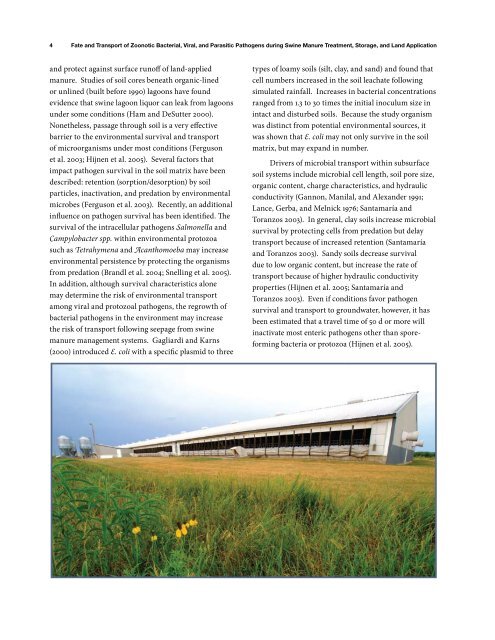Fate and Transport of Zoonotic Bacterial, Viral, and - The Pork Store ...
Fate and Transport of Zoonotic Bacterial, Viral, and - The Pork Store ...
Fate and Transport of Zoonotic Bacterial, Viral, and - The Pork Store ...
You also want an ePaper? Increase the reach of your titles
YUMPU automatically turns print PDFs into web optimized ePapers that Google loves.
4<br />
<strong>Fate</strong> <strong>and</strong> <strong>Transport</strong> <strong>of</strong> <strong>Zoonotic</strong> <strong>Bacterial</strong>, <strong>Viral</strong>, <strong>and</strong> Parasitic Pathogens during Swine Manure Treatment, Storage, <strong>and</strong> L<strong>and</strong> Application<br />
<strong>and</strong> protect against surface run<strong>of</strong>f <strong>of</strong> l<strong>and</strong>-applied<br />
manure. Studies <strong>of</strong> soil cores beneath organic-lined<br />
or unlined (built before 1990) lagoons have found<br />
evidence that swine lagoon liquor can leak from lagoons<br />
under some conditions (Ham <strong>and</strong> DeSutter 2000).<br />
Nonetheless, passage through soil is a very effective<br />
barrier to the environmental survival <strong>and</strong> transport<br />
<strong>of</strong> microorganisms under most conditions (Ferguson<br />
et al. 2003; Hijnen et al. 2005). Several factors that<br />
impact pathogen survival in the soil matrix have been<br />
described: retention (sorption/desorption) by soil<br />
particles, inactivation, <strong>and</strong> predation by environmental<br />
microbes (Ferguson et al. 2003). Recently, an additional<br />
influence on pathogen survival has been identified. <strong>The</strong><br />
survival <strong>of</strong> the intracellular pathogens Salmonella <strong>and</strong><br />
Campylobacter spp. within environmental protozoa<br />
such as Tetrahymena <strong>and</strong> Acanthomoeba may increase<br />
environmental persistence by protecting the organisms<br />
from predation (Br<strong>and</strong>l et al. 2004; Snelling et al. 2005).<br />
In addition, although survival characteristics alone<br />
may determine the risk <strong>of</strong> environmental transport<br />
among viral <strong>and</strong> protozoal pathogens, the regrowth <strong>of</strong><br />
bacterial pathogens in the environment may increase<br />
the risk <strong>of</strong> transport following seepage from swine<br />
manure management systems. Gagliardi <strong>and</strong> Karns<br />
(2000) introduced E. coli with a specific plasmid to three<br />
types <strong>of</strong> loamy soils (silt, clay, <strong>and</strong> s<strong>and</strong>) <strong>and</strong> found that<br />
cell numbers increased in the soil leachate following<br />
simulated rainfall. Increases in bacterial concentrations<br />
ranged from 1.3 to 30 times the initial inoculum size in<br />
intact <strong>and</strong> disturbed soils. Because the study organism<br />
was distinct from potential environmental sources, it<br />
was shown that E. coli may not only survive in the soil<br />
matrix, but may exp<strong>and</strong> in number.<br />
Drivers <strong>of</strong> microbial transport within subsurface<br />
soil systems include microbial cell length, soil pore size,<br />
organic content, charge characteristics, <strong>and</strong> hydraulic<br />
conductivity (Gannon, Manilal, <strong>and</strong> Alex<strong>and</strong>er 1991;<br />
Lance, Gerba, <strong>and</strong> Melnick 1976; Santamaría <strong>and</strong><br />
Toranzos 2003). In general, clay soils increase microbial<br />
survival by protecting cells from predation but delay<br />
transport because <strong>of</strong> increased retention (Santamaría<br />
<strong>and</strong> Toranzos 2003). S<strong>and</strong>y soils decrease survival<br />
due to low organic content, but increase the rate <strong>of</strong><br />
transport because <strong>of</strong> higher hydraulic conductivity<br />
properties (Hijnen et al. 2005; Santamaría <strong>and</strong><br />
Toranzos 2003). Even if conditions favor pathogen<br />
survival <strong>and</strong> transport to groundwater, however, it has<br />
been estimated that a travel time <strong>of</strong> 50 d or more will<br />
inactivate most enteric pathogens other than sporeforming<br />
bacteria or protozoa (Hijnen et al. 2005).


